You want to enable Cloud Guard in your tenancy. Which is NOT a prerequisite? Create LAM policies that allow Cloud Guard to read Oracle Cloud Infrastructure (OCI) resources.? (Choose the best Answer.)
Challenge 1 - Task 5 of 5
Authorize OCI Resources to Retrieve the Secret from the Vault
Scenario
You are working on a Python program running on a compute instance that needs to access an external service. To access the external service, the program needs credentials (password). Given that it is not a best security practice, you decide not to hard code the credential in the program. Instead, you store the password (secret) in a vault using the OCI Vault service. The requirement now is to authorize the compute instance so that the Python program can retrieve the password (secret) by making an API call to the OCI Vault.
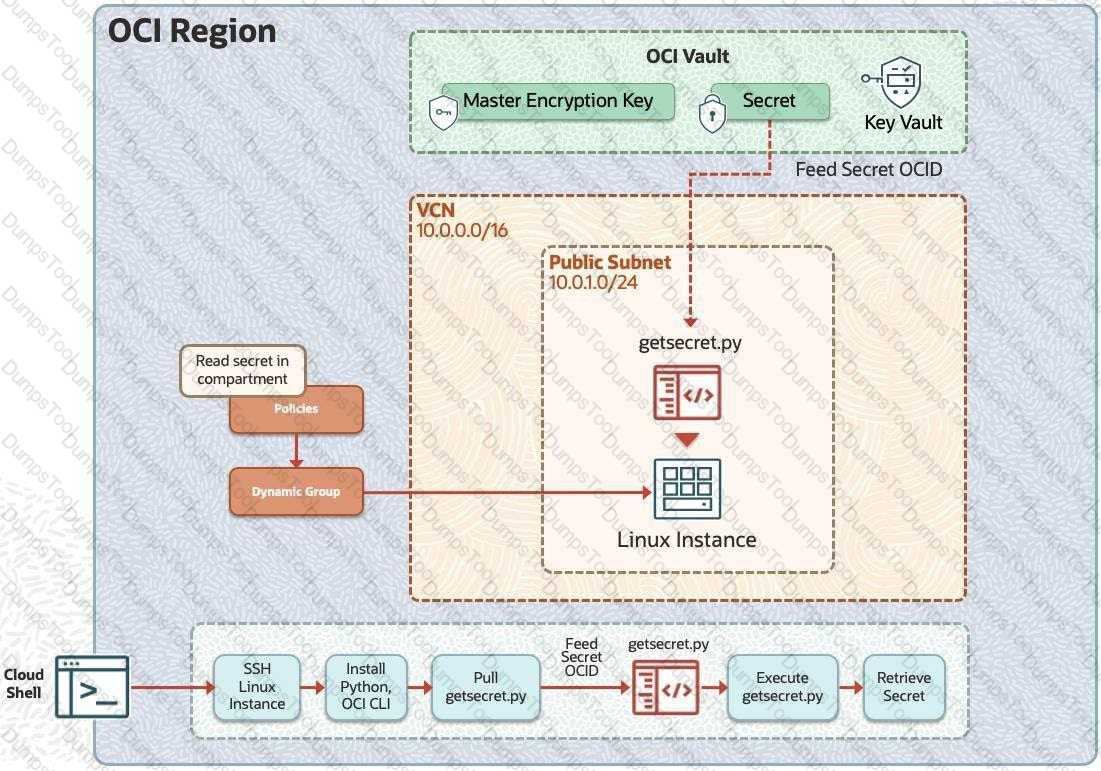
Preconfigured
To complete this requirement, you are provided with:
Note: You are provided with access to an OCI Tenancy, an assigned compartment, and OCI credentials. Throughout your exam, ensure to use the assigned Compartment 99234021-C01 and Region us-ashburn-1.
Challenge 4 - Task 2 of 6
Configure Web Application Firewall to Protect Web Server Against XSS Attack
Scenario
You have to protect web applications hosted on OCI from cross-site scripting (XSS) attacks. You can use the OCI Web Application Firewall (WAF) capabilities to create rules that compare against incoming requests to determine if the request contains an XSS attack payload. If a request is determined to be an attack, WAF should return the HTTP Service Unavailable (503) error.
To ensure that the configured WAF blocks the XSS attack, run the following script: [http:// /index.html? ) To complete this deployment, you have to perform the following tasks in the environment provisioned for you: Note: You are provided with access to an OCI Tenancy, an assigned compartment, and OCI credentials. Throughout your exam, ensure to use the assigned Compartment 99233424-C01 and Region us-ashburn-1. Complete the following task in the provisioned OCI environment: b. Enable Apache and start Apache server: c. Create a firewall rule to enable HTTP connection through port 80 and reload the firewall: d. Create an index file for your web server: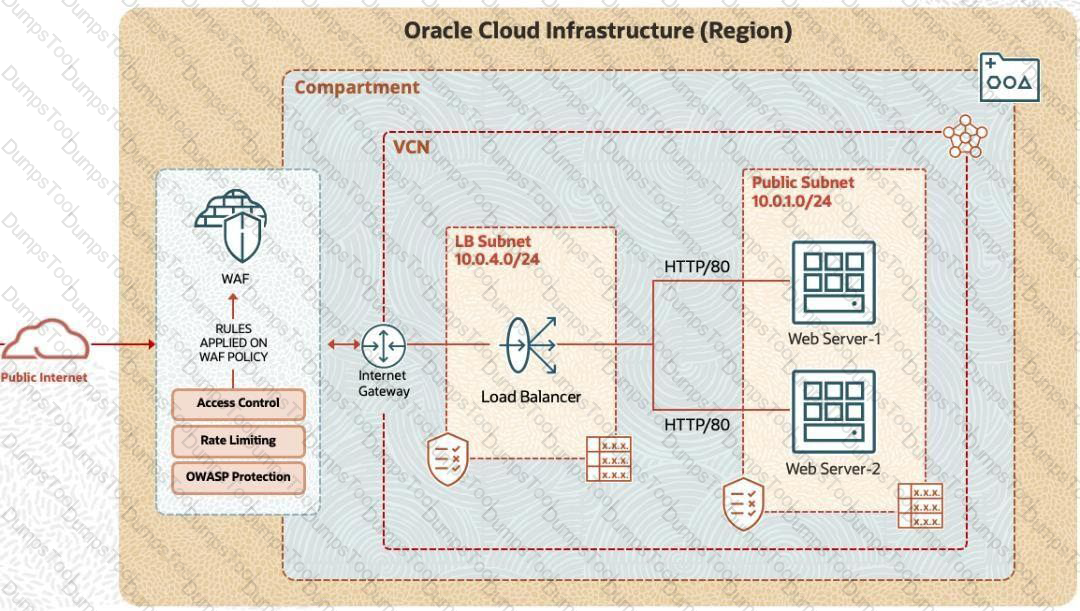
which three resources are required to encrypt a block volume with the customer managed key?
You configured the events service for your Cloud Guard problems to send email notifications, but you do not see any, which three things should you check to resolve this? (Choose three.)
Cloud Guard detected a risk score of zeroin the dashboard, what does this mean ?
Which statement about Oracle Cloud Infrastructure Multi-Factor Authentication (MFA)is NOT valid?
You have three compartments: ProjectA, ProjectB, and ProjectC. For each compartment, there is an admin group set up: A-Admins, B-Admins, and C-Admins. Each admin group has full access over their respective compartments as shown in the graphic below. Your organization has set up a tag namespace, EmployeeGroup.Role and all your admin groups are tagged with a value of 'Admin'.
You want to set up a "Test" compartment for members of the three projects to share, and need to give admin aress to all three of your existing admin groups. Which policy should you write to accomplish this task? (Choose the best Answer.)
Which are the three rules of engagement that apply to cloud penetration and vulnerability testing in Oracle Cloud Infrastructure (OCI)? (Choose three.)
An e-commerce company needs to authenticate with third-party API that don't support
OCI's signature-based authentication.
What can be the solution for the above scenario?
Which component helps move logging data to other services, such as archiving log data in object storage?
You create a new compartment, “apps,” to host some production apps and you create an apps_group and added users to it.
What would you do to ensure the users have access to the apps compartment?
Which storage type is most effective when you want to move some unstructured data, consisting of images and videos, to cloud storage?
Which two services can leverage Vault symmetric encryption keys for data-at-rest? (Choose two.) OR Which OCI services can encrypt all data-at-rest? (Choose two.)
Which VCNconfiguration is CORRECT with regard to VCN peering within a same region ?
Which cache rules criterion matches if the concatenation of the requested URL path and query are identical to the contents of the value field?
You subscribe to a PaaS service that follows the Shared Responsibility model.
Which type of security is your responsibility?
Which Virtual Cloud Network (VCN) configuration within a region will allow successful local peering using a local peering gateway? (Choose the best Answer.)
You are using a custom application with third-party APIs to manage application and data hosted in an Oracle Cloud Infrastructure(OCI) tenancy. Although your third-party APIs don't support OCI's signature-based authentication, you want them to communicate with OCI resources. Which authentication option must you use to ensure this?
Which is true regarding importing a symmetric key into Vault (Bring your own key)? (Choose the best Answer.)
In which two ways can you improve data durability in Oracle Cloud Infrastructure (OCI) Object Storage? (Choose two.)
Challenge 3 - Task 4 of 4
Set Up a Bastion Host to Access the Compute Instance in a Private Subnet Scenario
A compute instance is provisioned in a private subnet that is not accessible through the Internet. To access the compute instance resource in a private subnet, you must provide a time-bound SSH session without deploying and maintaining a public subnet and a jump server, which eliminates the hassle and potential attack surface from remote access.
To complete this deployment, you have to perform the following tasks in the environment provisioned for you:
• Configure a Virtual Cloud Network (VCN) and a Private Subnet.
• Provision a Compute Instance in the private subnet and enable Bastion Plugin.
• Create a Bastion and Bastion session.
• Connect to a compute instance using Managed SSH session.

Note: You are provided with access to an OCI Tenancy, an assigned compartment, and OCI credentials. Throughout your exam, ensure to use the assigned Compartment 99233424-C01 and Region us-ashburn-1
Complete the following tasks in the provisioned OCI environment:
Connect to a compute instance using a Managed SSH Bastion session from your local machine terminal or Cloud shell.
Challenge 4 - Task 3 of 6
Configure Web Application Firewall to Protect Web Server Against XSS Attack
Scenario
You have to protect web applications hosted on OCI from cross-site scripting (XSS) attacks. You can use the OCI Web Application Firewall (WAF) capabilities to create rules that compare against incoming requests to determine if the request contains an XSS attack payload. If a request is determined to be an attack, WAF should return the HTTP Service Unavailable (503) error.
To ensure that the configured WAF blocks the XSS attack, run the following script: [http:// /index.html? ) To complete this deployment, you have to perform the following tasks in the environment provisioned for you: Note: You are provided with access to an OCI Tenancy, an assigned compartment, and OCI credentials. Throughout your exam, ensure to use the assigned Compartment 99233424-C01 and Region us-ashburn-1. Complete the following task in the provisioned OCI environment: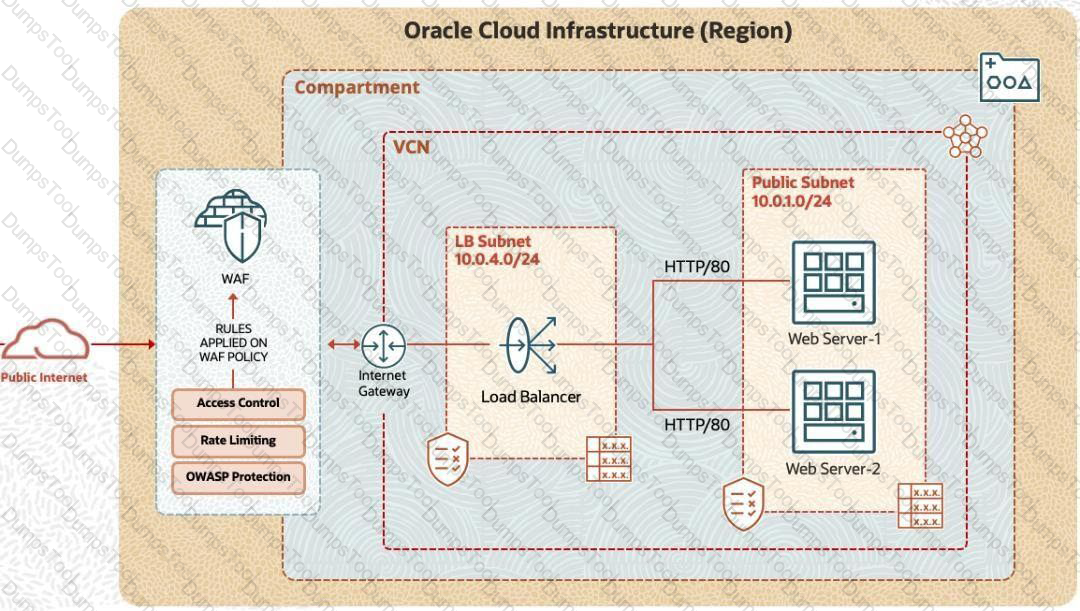
Challenge 4 - Task 5 of 6
Configure Web Application Firewall to Protect Web Server Against XSS Attack
Scenario
You have to protect web applications hosted on OCI from cross-site scripting (XSS) attacks. You can use the OCI Web Application Firewall (WAF) capabilities to create rules that compare against incoming requests to determine if the request contains an XSS attack payload. If a request is determined to be an attack, WAF should return the HTTP Service Unavailable (503) error.
To ensure that the configured WAF blocks the XSS attack, run the following script: [http:// /index.html? ) To complete this deployment, you have to perform the following tasks in the environment provisioned for you: Note: You are provided with access to an OCI Tenancy, an assigned compartment, and OCI credentials. Throughout your exam, ensure to use the assigned Compartment 99233424-C01 and Region us-ashburn-1. Complete the following task in the provisioned OCI environment: 1. Create a Protection Rule with name WAF-PBT-XSS-Protection against XSS attack. for protecting web server 2. Create a New Rule Action with name WAF-PBT-XSS-Action where http response code will be 503 (Service Unavailable).
Challenge 4 - Task 1 of 6
Configure Web Application Firewall to Protect Web Server Against XSS Attack
Scenario
You have to protect web applications hosted on OCI from cross-site scripting (XSS) attacks. You can use the OCI Web Application Firewall (WAF) capabilities to create rules that compare against incoming requests to determine if the request contains an XSS attack payload. If a request is determined to be an attack, WAF should return the HTTP Service Unavailable (503) error.
To ensure that the configured WAF blocks the XSS attack, run the following script: [http:// /index.html? ) To complete this deployment, you have to perform the following tasks in the environment provisioned for you: Note: You are provided with access to an OCI Tenancy, an assigned compartment, and OCI credentials. Throughout your exam, ensure to use the assigned Compartment 99233424-C01 and Region us-ashburn-1. Complete the following task in the provisioned OCI environment: Create a VCN using wizard with the name IAD-WAF-PBT-VCN-01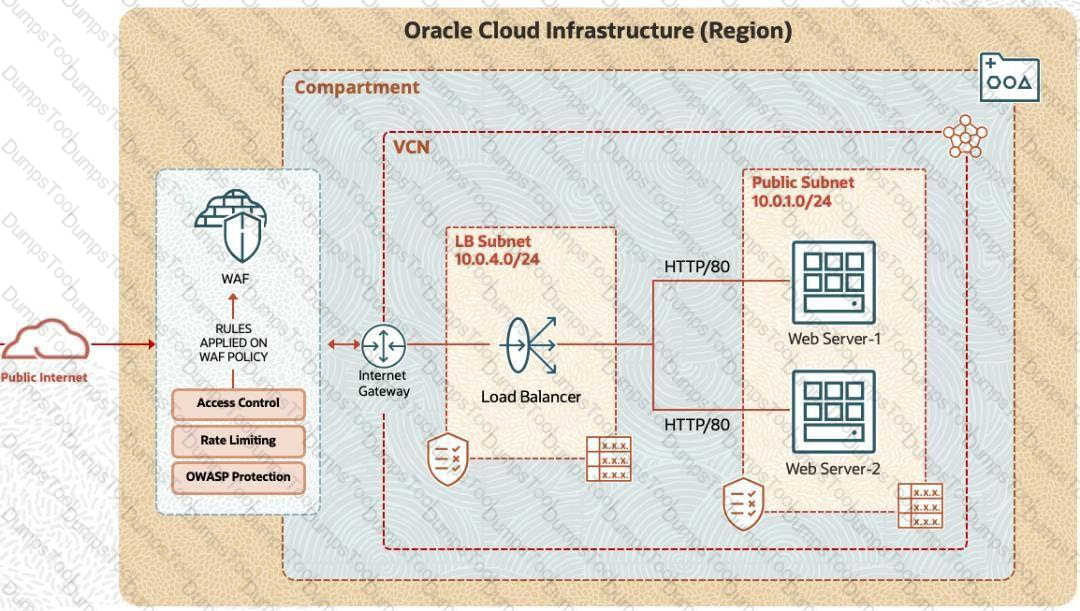
Challenge 3 - Task 3 of 4
Set Up a Bastion Host to Access the Compute Instance in a Private Subnet Scenario
A compute instance is provisioned in a private subnet that is not accessible through the Internet. To access the compute instance resource in a private subnet, you must provide a time-bound SSH session without deploying and maintaining a public subnet and a jump server, which eliminates the hassle and potential attack surface from remote access.
To complete this deployment, you have to perform the following tasks in the environment provisioned for you:
• Configure a Virtual Cloud Network (VCN) and a Private Subnet.
• Provision a Compute Instance in the private subnet and enable Bastion Plugin.
• Create a Bastion and Bastion session.
• Connect to a compute instance using Managed SSH session.
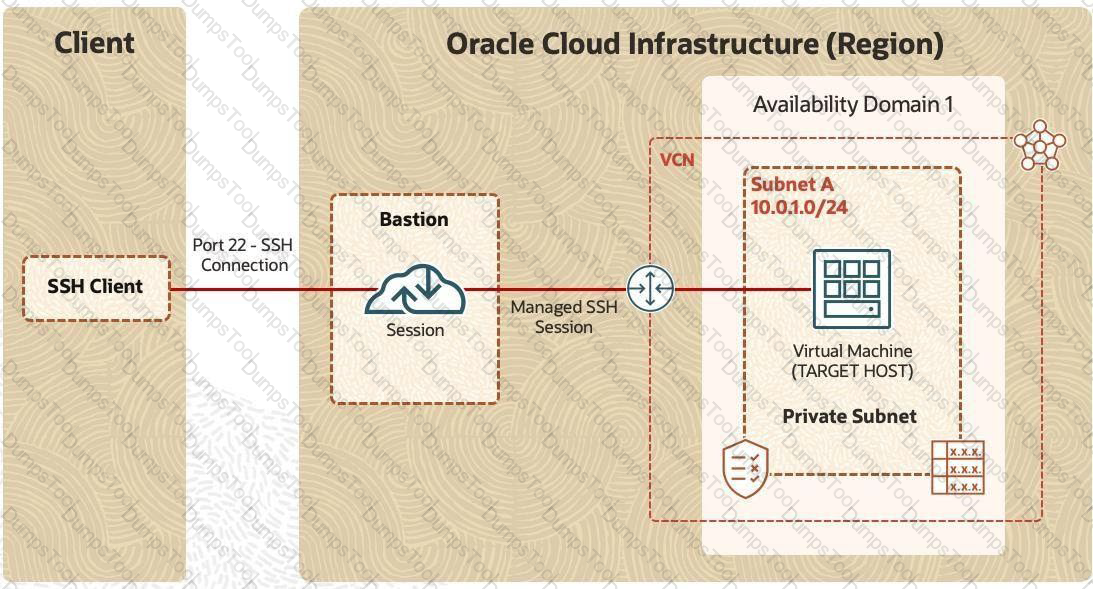
Note: You are provided with access to an OCI Tenancy, an assigned compartment, and OCI credentials. Throughout your exam, ensure to use the assigned Compartment 99233424-C01 and Region us-ashburn-1
Complete the following tasks in the provisioned OCI environment:
1. Create a Bastion with the name SPPBTBASTION99233424-lab.user01
[Eliminate Specical Characters] Eg:SPPBTBASTION992831403labuser13
2. Create a Session with the name PBT-1-Session-01, for compute instance in private subnet, with default username as "opc"
Challenge 4 - Task 4 of 6
Configure Web Application Firewall to Protect Web Server Against XSS Attack
Scenario
You have to protect web applications hosted on OCI from cross-site scripting (XSS) attacks. You can use the OCI Web Application Firewall (WAF) capabilities to create rules that compare against incoming requests to determine if the request contains an XSS attack payload. If a request is determined to be an attack, WAF should return the HTTP Service Unavailable (503) error.
To ensure that the configured WAF blocks the XSS attack, run the following script: [http:// /index.html? ) To complete this deployment, you have to perform the following tasks in the environment provisioned for you: Note: You are provided with access to an OCI Tenancy, an assigned compartment, and OCI credentials. Throughout your exam, ensure to use the assigned Compartment 99233424-C01 and Region us-ashburn-1. Complete the following task in the provisioned OCI environment: Create a WAF policy with the name IAD-SP-PBT-WAF-01_99233424-lab.user01 Eg: IAD-SP-PBT-WAF-01_99232403-lab.user02
Challenge 1 - Task 2 of 5
Authorize OCI Resources to Retrieve the Secret from the Vault
Scenario
You are working on a Python program running on a compute instance that needs to access an external service. To access the external service, the program needs credentials (password). Given that it is not a good security practice, you decide not to hard code the credential in the program. Instead, you store the password (secret) in a vault using the OCI Vault service. The requirement now is to authorize the compute instance so that the Python program can retrieve the password (secret) by making an API call to the OCI Vault.

Preconfigured:
To complete this requirement, you are provided with:
Note: You are provided with access to an OCI Tenancy, an assigned compartment, and OCI credentials. Throughout your exam, ensure to use the assigned Compartment 99234021-C01 and Region us-ashburn-1.
Complete the following task:
In the field below, write the IAM policy, which allows a program running on a computer instance (principal instance) to retrieve a secret from the OCI Vault.
Challenge 1 - Task 3 of 5
Authorize OCI Resources to Retrieve the Secret from the Vault
Scenario
You are working on a Python program running on a compute instance that needs to access an external service. To access the external service, the program needs credentials (password). Given that it is not a best security practice, you decide not to hard code the credential in the program. Instead, you store the password (secret) in a vault using the OCI Vault service. The requirement now is to authorize the compute instance so that the Python program can retrieve the password (secret) by making an API call to the OCI Vault.
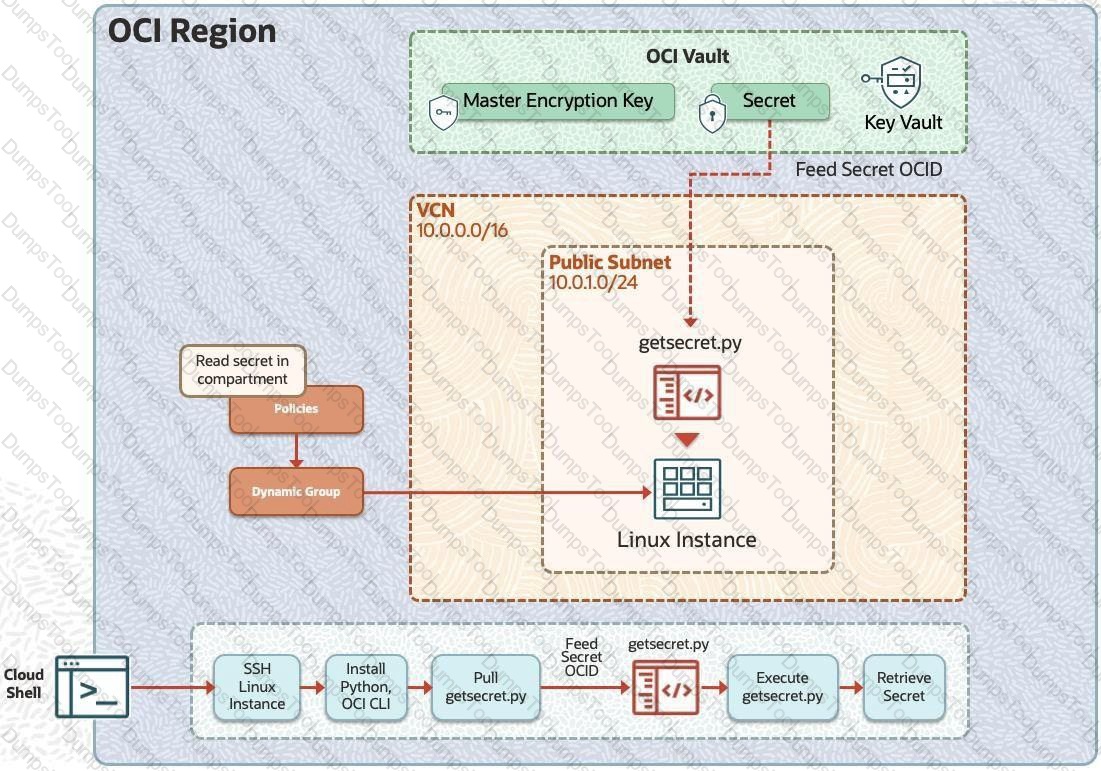
Preconfigured
To complete this requirement, you are provided with:
Note: You are provided with access to an OCI Tenancy, an assigned compartment, and OCI credentials. Throughout your exam, ensure to use the assigned Compartment 99234021-C01 and Region us-ashburn-1.
Complete the following task in the OCI environment provisioned:
Create a new VCN with the name PBT_SECRET_VCN01 and public subnet within your assigned compartment.
Challenge 1 - Task 1 of 5
Authorize OCI Resources to Retrieve the Secret from the Vault
Scenario:
You are working on a Python program running on a compute instance that needs to access an external service. To access the external service, the program needs credentials (password). Given that it is not a best security practice, you decide not to hard code the credential in the program. Instead, you store the password (secret) in a vault using the OCI Vault service. The requirement now is to authorize the compute instance so that the Python program can retrieve the password (secret) by making an API call to the OCI Vault.
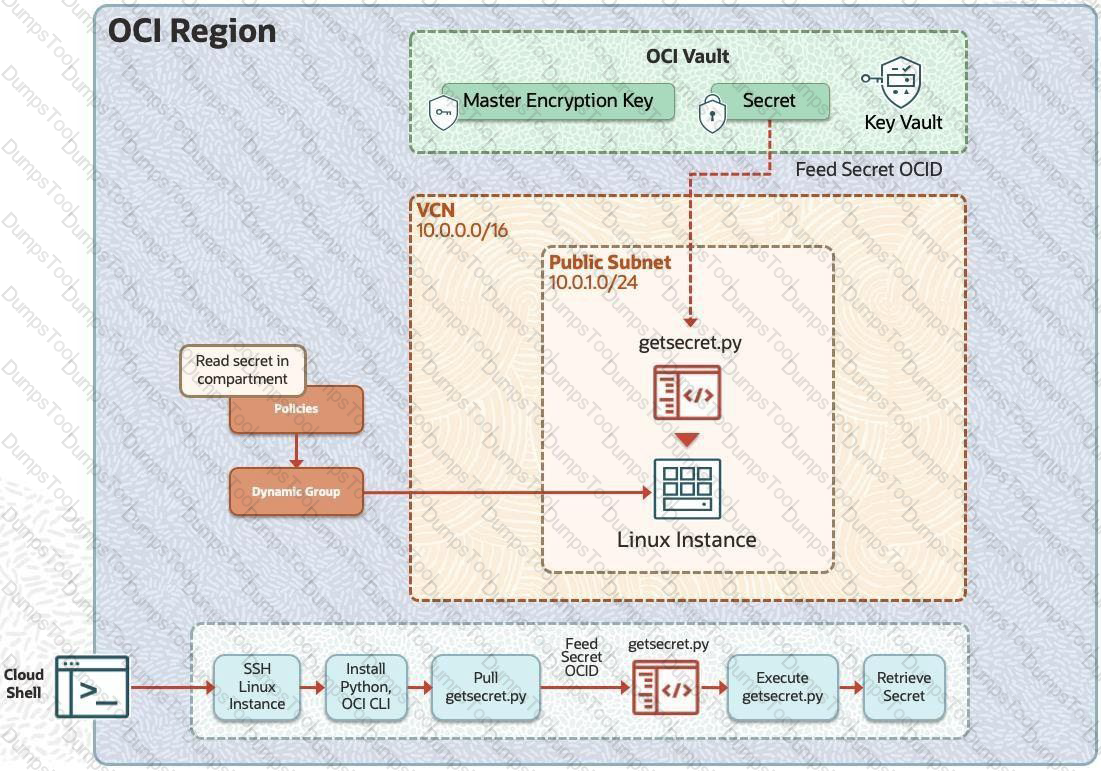
Preconfigured:
To complete this requirement, you are provided with:
Note: You are provided with access to an OCI Tenancy, an assigned compartment, and OCI credentials. Throughout your exam, ensure to use the assigned Compartment 99234021-C01 and Region us-ashburn-1.
Complete the following tasks in the OCI environment provisioned:
For example: If your user name is 99346163-lab.user02, then the secret should be named as my-pbt-secret_99346163-lab.user02.